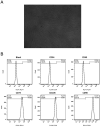WJ‑MSCs intervention may relieve intrauterine adhesions in female rats via TGF‑β1‑mediated Rho/ROCK signaling inhibition
- PMID: 33179074
- PMCID: PMC7673328
- DOI: 10.3892/mmr.2020.11646
WJ‑MSCs intervention may relieve intrauterine adhesions in female rats via TGF‑β1‑mediated Rho/ROCK signaling inhibition
Abstract
Estrogen is a commonly used hormone in the adjuvant treatment of intrauterine adhesion (IUA), which can promote endometrial growth. Stem cell transplantation has also been reported to promote endometrial regeneration in IUA due to its potential differentiative capacity. Human Wharton's jelly mesenchymal stem cells (WJ‑MSCs) are isolated from the umbilical cord, possess strong self‑renewal and proliferative abilities, and are hypo‑immunogenic and non‑tumorigenic. Therefore, the present study aimed to investigate the therapeutic effects and underlying mechanism of WJ‑MSCs transplantation with estrogen treatment, separately or as a combined therapy, on IUA. The IUA model was established using the ethanol damage method. A total of 50 Sprague‑Dawley female rats were randomly divided into the control, IUA model, WJ‑MSCs treatment, estrogen treatment and WJ‑MSCs+ estrogen treatment groups (n=10/group). WJ‑MSCs were injected three times at 5‑day intervals. IUA rats in the estrogen group received 0.2 mg/kg estrogen through intragastric administration, once every 2 days for 8 weeks. Morphological changes were evaluated by hematoxylin‑eosin staining. Immunohistochemical evaluations of pan‑keratin, vimentin, transforming growth factor (TGF)‑β1, RhoA, RhoB, RhoC, Rho‑associated coiled‑coil‑containing protein kinase (ROCK)I, and ROCKII expression were performed in uterine tissue. After treatment, the uterine specimens were observed to have increased uterine thickness and gland numbers in all treatment groups compared with the IUA group; however, the degree of restoration in the independent WJ‑MSCs and estrogen treatment groups was better than in the combined treatment group. Immunohistochemical analysis demonstrated that pan‑keratin expression was increased, and RhoA, ROCKI and TGF‑β1 expression was significantly inhibited in the WJ‑MSCs and WJ‑MSCs + estrogen treatment groups compared with the IUA group; however, the expression levels of these proteins were similar among all treatment groups. No change in vimentin expression was detected in any treatment group. The expression levels of RhoB, RhoC and ROCKII were clearly not affected by WJ‑MSCs intervention alone. In conclusion, transplantation of WJ‑MSCs may repair endometrial damage in IUA rats via TGF‑β1‑mediated inhibition of RhoA/ROCKI signaling.
Keywords: intrauterine adhesion; Wharton's jelly mesenchymal stem cells; transforming growth factor‑β1; RhoA/ROCKI signaling pathway.
Figures






References
-
- Luo S, Shen L, Zhang X. Clearing heat and activating blood method for intrauterine adhesion. J Changchun Univ Tradit Chin Med. 2016;1:78–80.
-
- Panayotidis C, Weyers S, Bosteels J, Herendael BV. Intrauterine adhesions (IUA): Has there been progress in understanding and treatment over the last 20 years? Gynecol Surg. 2009;6:197–211. doi: 10.1007/s10397-008-0421-y. - DOI
Publication types
MeSH terms
Substances
LinkOut - more resources
Full Text Sources
Medical

